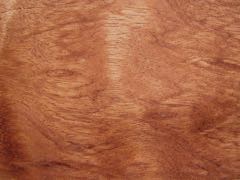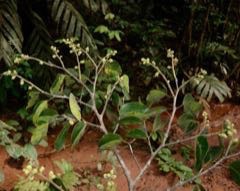 |
|
Philipp Zinger wikimedia.org |
 |
| Ehoarn Bidault mobot.org |
Translate this page:
Summary
Guibourtia tessmannii is a large tree of about 65m tall and up to 200 cm in diameter with thin, irregular, high buttresses. It is commonly found in west tropical Africa. The wood is heavy to very heavy, hard to very hard, durable, and resistant to fungi, dry wood borers and termites. It is very decorative and is often used for veneers, high class furniture, cabinet work, turnery, flooring, stairs, heavy carpentry, etc.
Physical Characteristics

 Guibourtia tessmannii is an evergreen Tree growing to 50 m (164ft) by 35 m (114ft) at a slow rate.
Guibourtia tessmannii is an evergreen Tree growing to 50 m (164ft) by 35 m (114ft) at a slow rate.
See above for USDA hardiness. It is hardy to UK zone 10. The flowers are pollinated by Insects.
It can fix Nitrogen.
Suitable for: light (sandy), medium (loamy) and heavy (clay) soils and prefers well-drained soil. Suitable pH: mildly acid, neutral and basic (mildly alkaline) soils. It cannot grow in the shade. It prefers moist soil.
UK Hardiness Map
US Hardiness Map
Synonyms
Copaifera tessmannii Harms
Plant Habitats
Edible Uses
References More on Edible Uses
Medicinal Uses
Plants For A Future can not take any responsibility for any adverse effects from the use of plants. Always seek advice from a professional before using a plant medicinally.
None known
References More on Medicinal Uses
The Bookshop: Edible Plant Books
Our Latest books on Perennial Plants For Food Forests and Permaculture Gardens in paperback or digital formats.

Edible Tropical Plants
Food Forest Plants for Hotter Conditions: 250+ Plants For Tropical Food Forests & Permaculture Gardens.
More

Edible Temperate Plants
Plants for Your Food Forest: 500 Plants for Temperate Food Forests & Permaculture Gardens.
More

More Books
PFAF have eight books available in paperback and digital formats. Browse the shop for more information.
Shop Now
Other Uses
Furniture Wood
Other Uses: The heartwood is a pink or reddish brown with some fine, purplish-red veins and some brown veins; it is clearly demarcated from the 2 - 8cm wide band of sapwood. The texture is medium; the grain straight or interlocked, sometimes wavy. The wood is heavy to very heavy; hard to very hard; moderately to very elastic; durable, being resistant to fungi, dry wood borers and termites. It seasons slowly, with a high risk of checking and distortion; once dry it is poorly stable in service. The wood has a high blunting effect - stellite-tipped and tungsten carbide tools are recommended; care is needed when working with interlocked grains; nailing and screwing are good, but require pre-boring; gluing is correct for internal purposes only and needs to be done with care because the wood is dry and smooth. The wood is very decorative and is often used for veneers, it is also used to make high class furniture, cabinet work, turnery, flooring, stairs, heavy carpentry, joinery, panelling, railway sleepers etc[848 ].
Special Uses
Nitrogen Fixer
References More on Other Uses
Cultivation details
References Carbon Farming Information and Carbon Sequestration Information
Temperature Converter
Type a value in the Celsius field to convert the value to Fahrenheit:
Fahrenheit:
The PFAF Bookshop
Plants For A Future have a number of books available in paperback and digital form. Book titles include Edible Plants, Edible Perennials, Edible Trees,Edible Shrubs, Woodland Gardening, and Temperate Food Forest Plants. Our new book is Food Forest Plants For Hotter Conditions (Tropical and Sub-Tropical).
Shop Now
Plant Propagation
Seed
Other Names
If available other names are mentioned here
Bubinga, Kevazingo
Native Range
AFRICA: Cameroon, Gabon, Equatorial Guinea
Weed Potential
Right plant wrong place. We are currently updating this section.
Please note that a plant may be invasive in one area but may not in your area so it's worth checking.
Conservation Status
IUCN Red List of Threatened Plants Status : This taxon has not yet been assessed

Growth: S = slow M = medium F = fast. Soil: L = light (sandy) M = medium H = heavy (clay). pH: A = acid N = neutral B = basic (alkaline). Shade: F = full shade S = semi-shade N = no shade. Moisture: D = dry M = Moist We = wet Wa = water.
Now available:
Food Forest Plants for Mediterranean Conditions
350+ Perennial Plants For Mediterranean and Drier Food Forests and Permaculture Gardens.
[Paperback and eBook]
This is the third in Plants For A Future's series of plant guides for food forests tailored to
specific climate zones. Following volumes on temperate and tropical ecosystems, this book focuses
on species suited to Mediterranean conditions—regions with hot, dry summers and cool, wet winters,
often facing the added challenge of climate change.
Read More
Expert comment
Author
(Harms) J.L'onard
Botanical References
1
Links / References
For a list of references used on this page please go here
A special thanks to Ken Fern for some of the information used on this page.
Readers comment
| Add a comment |
|
If you have important information about this plant that may help other users please add a comment or link below. Only comments or links that are felt to be directly relevant to a plant will be included. If you think a comment/link or information contained on this page is inaccurate or misleading we would welcome your feedback at [email protected]. If you have questions about a plant please use the Forum on this website as we do not have the resources to answer questions ourselves.
* Please note: the comments by website users are not necessarily those held by PFAF and may give misleading or inaccurate information.
To leave a comment please Register or login here All comments need to be approved so will not appear immediately.
|
Subject : Guibourtia tessmannii
|
|
|
|